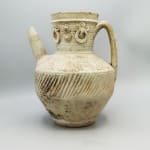Umayyad or Abbasid Unglazed Jug , Seventh to Ninth Century AD
Ceramic
25.5 x 21 cm
10 x 8 1/4 in
10 x 8 1/4 in
CC.92
Further images
-
(View a larger image of thumbnail 1
)

-
(View a larger image of thumbnail 2
)

-
(View a larger image of thumbnail 3
)

-
(View a larger image of thumbnail 4
)

-
(View a larger image of thumbnail 5
)

-
(View a larger image of thumbnail 6
)

-
(View a larger image of thumbnail 7
)

-
(View a larger image of thumbnail 8
)

-
(View a larger image of thumbnail 9
)

Following the death of the prophet Muhammad in AD 632, the future of Islam lay in the hands of four successive Caliphs, who sought to build on Muhammad’s legacy and...
Following the death of the prophet Muhammad in AD 632, the future of Islam lay in the hands of four successive Caliphs, who sought to build on Muhammad’s legacy and expand the frontiers of Islam. The final of these Caliphs, Muhammad’s cousin Ali ibn Abi Talib, deposed various regional governors, whom he considered corrupt. This included Mu’awiya, the brother of a previous Caliph; Mu’awiya would not tolerate such an indignity, and began a brutal and bloody civil war, known as the First Fitna. The conflict ended with the assassination of Ali, as he prayed in the Mosque of Kufa, in AD 661. Mu’awiya became Caliph, and founded the Umayyad Dynasty. No longer would the Caliph be chosen by his predecessor, or by a council of leading Muslims. Instead, the Caliphate became a hereditary monarchy, with Mu’awiya at the centre. For a hundred years, Mu’awiya and his successors dominated the Muslim world. But this was not to last; they were overthrown by the Abbasid Dynasty, descended from Muhammad’s uncle Abbas ibn Abd al-Muttalib, and supported by the followers of Ali, who never accepted his assassination or the new Umayyad rule.
The Umayyads and the subsequent Abbasids laid the foundation for Islamic art. At first, the main influences were the Late Antique naturalistic tradition, and the more formal modes of Byzantine and Sassanid art. But gradually, the Islamic world began to formulate its own artistic forms, focussed especially on animal, vegetal and figural motifs. This robust vessel shows an interesting marriage of decoration and form. A narrow foot rises out towards a cylindrical body, decorated with diagonal strokes all around. The shoulder of the vessel is shallow, and is decorated with more organic or calligraphic forms, consisting of two sinuous swirling motifs between which are a series of stamped circles. The neck of the vessel is unusual: it is decorated with a series of stripes, but also with forms added on to the clay, including circular forms that resemble door knockers, with three circles above, and little rosettes that sit between them. From the shoulder sprout a spout and the handle, which joins the neck just below the rim.
Scholarship has been dismissive of the Umayyad and early Abbasid pottery, with one article suggesting that ‘there was little pottery of merit’ from the period. Most scholarly attention is drawn to the later Abbasid: in AD 800, the first traders from Tang Dynasty China made their way to the Abbasid heartland, and brought with them the decorative techniques of the Chinese potters. After then, Islamic pottery is associated with the same ingenious use of glazes, and the same experimentation with form and function, which characterises Chinese porcelain. However, there is much that is noteworthy about these early Umayyad and Abbasid attempts. While it may be unglazed, and the handiwork a little rough and ready, the elegance of the form, and the intricacy of the decoration should not be underestimated.
The Umayyads and the subsequent Abbasids laid the foundation for Islamic art. At first, the main influences were the Late Antique naturalistic tradition, and the more formal modes of Byzantine and Sassanid art. But gradually, the Islamic world began to formulate its own artistic forms, focussed especially on animal, vegetal and figural motifs. This robust vessel shows an interesting marriage of decoration and form. A narrow foot rises out towards a cylindrical body, decorated with diagonal strokes all around. The shoulder of the vessel is shallow, and is decorated with more organic or calligraphic forms, consisting of two sinuous swirling motifs between which are a series of stamped circles. The neck of the vessel is unusual: it is decorated with a series of stripes, but also with forms added on to the clay, including circular forms that resemble door knockers, with three circles above, and little rosettes that sit between them. From the shoulder sprout a spout and the handle, which joins the neck just below the rim.
Scholarship has been dismissive of the Umayyad and early Abbasid pottery, with one article suggesting that ‘there was little pottery of merit’ from the period. Most scholarly attention is drawn to the later Abbasid: in AD 800, the first traders from Tang Dynasty China made their way to the Abbasid heartland, and brought with them the decorative techniques of the Chinese potters. After then, Islamic pottery is associated with the same ingenious use of glazes, and the same experimentation with form and function, which characterises Chinese porcelain. However, there is much that is noteworthy about these early Umayyad and Abbasid attempts. While it may be unglazed, and the handiwork a little rough and ready, the elegance of the form, and the intricacy of the decoration should not be underestimated.








